Graphics Reference
In-Depth Information
2
2
2
FGFxwy
=-=- + + +
=+-
4
8
3
3
z
w
1
[
(
)
(
)
-+
(
)
(
)
]
22 22
22
22 2 22 2
Gy
z
wx
-
2
xwy
+
+
z
y
z
4
x
++-
y
z
wx
1
(
)
-
(
)
.
2
2
2
2
2
2
=-
xy zw
33
-
-
2
wyzw
+
-
Choosing the simpler equation F
1
= 0 to solve for x, we get
2
2
2
33
8
yzw
w
++
x
=
.
Substituting this expression for x in G and dehomogenizing, that is, setting w to 1,
gives us the equation
2
2
2
2
2
Ê
Á
331
8
yz
++
ˆ
˜
Ê
Á
331
8
yz
++
ˆ
˜
++=.
22
-
2
yz
0
(13.32)
Equation (13.32) defines the circle
y
22
59
+=
in the y-z plane. (To see this, let u = y
2
+ z
2
in equation (13.32) and solve for u.)
Notice that we can run into serious problems if the wrong variable is chosen at
Step 2. For example, choosing y we would get
2
2
F
=-=- -
G
F
32
x
xw
+
w
1
2
2
G
=
3
x y
-
w y
+
2
xwy
1
and we are not able to solve for y. The reason that x worked and y does not is
that the intersection projects nicely in a one-to-one fashion to the y-z plane using an
orthographic projection parallel to the x-axis whereas projecting parallel to the y-axis
collapses the intersection to a closed segment.
One problem with the above approach is that it has the potential to introduce
extraneous factors and solutions. The intersection of
X
and
S
1
may be larger than the
intersection of
S
1
and
S
2
. See [Hoff89] for examples of this.
The Projection Approach.
The idea here is to use a central projection from some
point
p
to project the space curve to a plane curve. The only problem is choosing
p
correctly. We do not want the projection to introduce any singularities so that the map
cannot be inverted. [Hoff89] describes a method that works with a high probability.
Step 1.
Transform the surface equations by a linear transformation defined by a
matrix with symbolic coefficients.
Step 2.
Use the resultant to project the intersection.
Step 3.
Substitute random values for the symbolic coefficients and check that the
projection has the desired properties.



